Prints for sale
Prints are available for sale from £45
each. Payments are via PayPal.
Hawfinches &
Winter Thrushes
£50 (inc UK delivery)
I’ve recently completed the last of the studio paintings for the Wildlife Trusts’ Undersea Art Award. Inspired by my experiences diving in the North Sea off the coast of Northumberland and South East Scotland, these paintings have been produced from underwater sketches and photographs made on the dives, and from memory.
The fish is a Ballan wrasse – a fairly common species that is often very approachable as they are often fed by divers. The Lion’s mane jellyfish is also widespread and is one of our most attractive jellyfish. The guillemot was seen at about 6 metres depth while on a decompression stop at the end of a dive at St Abb’s Head – home of a well known seabird breeding colony.
These paintings and all of the other studio work and field sketches, including those made underwater, will be on show at the The Natural Eye exhibition of the Society of Wildlife Artists (SWLA) at the Mall Galleries, London, from October 29th – 8th November.
I have just completed my first big studio painting for the Wildlife Trusts’ Undersea Art Award. This oil painting, measuring 112cm x 107cm, was inspired by the St Mary’s dive I describe in my previous post. It will be shown at the Society of Wildlife Artists (SWLA) annual exhibition ‘The Natural Eye’ in October, along with field work and other studio work as yet not completed.
This painting contains more than just seals and kelp; there is a nudibranch (sea-slug), a blue-rayed limpet and some fish. It’s a little like the underwater version of ‘Spot the Ball’!
Despite an appalling summer for diving I managed a dive recently at St Mary’s Island, just to the north of Newcastle, with my dive buddy Nic Faulks. This is part of the proposed Marine Conservation Zone (rMCZ) I want to explore for the Wildlife Trusts’ Undersea Art Award. Although visibility wasn’t great at 4m-6m, we had barely entered the water when some young, grey seals started taking an interest in us. Initially circling around us, just within visible range, they soon became bolder and eventually accepted us as harmless curiosities.
Despite years of experience of drawing often fast-moving birds and animals from life, nothing quite prepares you for the difficulties of drawing animals moving underwater. I have sketched and painted seals above water many times but their shapes underwater are totally different – gone are the lumbering forms that bask on rocks and sand bars and in their place are lithe bodies that continuously change shape and angle, particularly when at one moment they are at the side of you and the next they are above or below you. Add to this the task of trying to wrestle with a floating sketch pad whilst wearing thick, neoprene gloves and at the same time fighting a current that wants to take you in a different direction entirely, and you start to get the measure of the challenge! However, I managed to make a few, crude sketches.
Their curiosity doubtless aroused still further by the flailing antics of this bubble-emitting alien, the seals lost all fear and came right up to us, one going as far as pressing it’s muzzle against the camera lens as I tried to get a head shot!
Unfortunately visibility worsened and we had to head back, but not before Nic found the most beautiful little cowrie – only a centimetre long these extraordinary molluscs cover their shells with a retractable, soft-tissue mantle that lays down a glossy coating on the shell. You can see it as a darker grey area on the side of the shell, bordered by a yellow line. The top, paler section of shell is the uncovered part.
Back on land I did a quick acrylic sketch from memory of the ‘seal experience’ and already have an idea to translate this in to a big oil painting.
I’m hoping to get another dive in this weekend and then I have to knuckle down and get some studio painting done!
I recently dived at the Farne Islands with the BBC Countryfile film crew and presenter Matt Baker. We were blessed with fantastic weather; the sky was clear and the sea was calm and blue – idyllic! The visibilty underwater was not brilliant but it was enough to get some underwater sketching and filming done.
We set off from the harbour at Seahouses and en route Matt interviewed me about the award and about how I was going to draw underwater. I had put together a kit that involved waterproof paper – a plastic paper that takes normal graphite pencil extremely well. This was a bit of an experiment as I hadn’t tried it out yet, except for in the bath! I brought along a second set of drawing equipment so that Matt could have a go too.
We kitted up (undressing in front of TV cameras was a little worrying!) and then jumped in. Six people underwater; myself, Matt, a cameraman and three safety divers – one dive buddy each. We were only in about 6 metres of water and at this site the sea bed was mostly just kelp forest, but there were tiny fish, sea-urchins, crabs and jellyfish to see. My dive buddy Nicola Faulks – an extremely experienced diver and top all-round naturalist – found a beautiful nudibranch or sea-slug. It was minute! Barely half a centimetre long it was pure white with bright yellow spots at the ends of it’s ‘tentacles’. How she ever found it I’ll never know but Matt and I attempted some sketches.
Being filmed sketching
A crab was discovered and somehow ended up crawling up my arm – completely unkown to me! A beautiful lion’s mane jellyfish was also seen at the end of the dive.
Reluctantly it was time to end the dive. Back on the boat Matt and I reviewed our underwater artwork for the camera before heading back to shore.
Underwater drawings of jellyfish and small pollock.
Just time for a quick team photo; Ali Plummer (Wildlife Trusts’ Living Seas Officer), Matt Baker, Chris Rose (that’s me!) and my excellent dive buddy and all-round good egg, Nic Faulks.
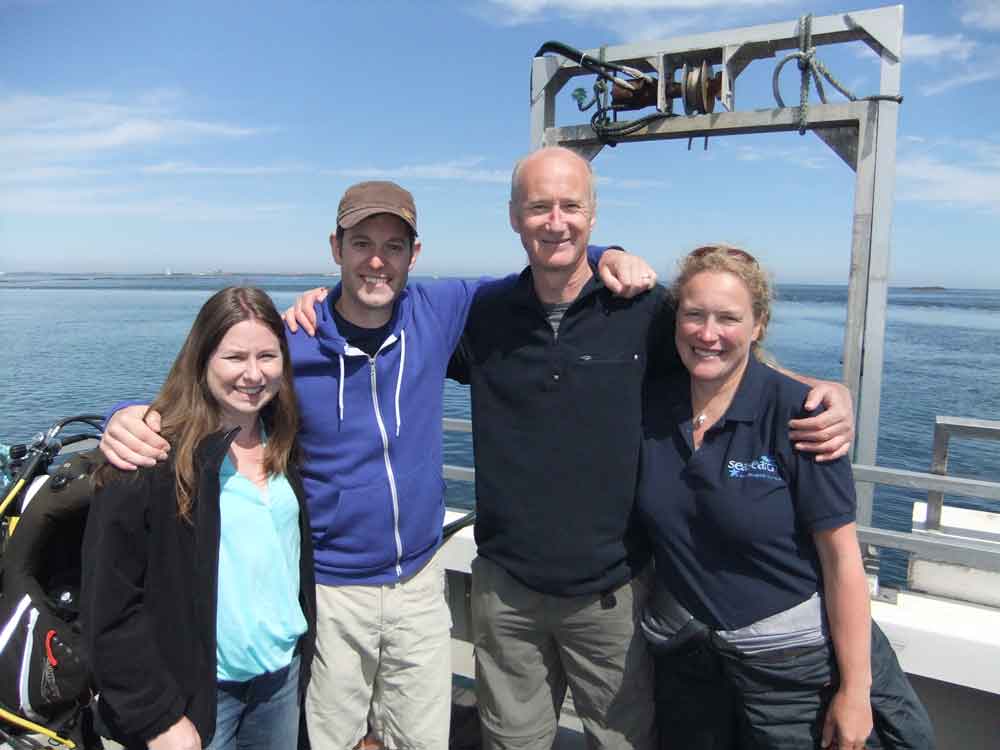 Back on shore I spent some time doing a quick field painting from memory, while the colours were still fairly fresh in my mind. I tried to incorporate some of the elements from the dive that appealed to me; the Mermaid’s tresses (long, filamentous seaweeds), the kelp and a few fish and a lion’s mane jellyfish.
Back on shore I spent some time doing a quick field painting from memory, while the colours were still fairly fresh in my mind. I tried to incorporate some of the elements from the dive that appealed to me; the Mermaid’s tresses (long, filamentous seaweeds), the kelp and a few fish and a lion’s mane jellyfish.
Post-dive acrylic sketch and underwater sketches of a nudibranch and a sea-urchin.
Last Sunday I had a couple of great practice dives at the famous St Abbs Marine Reserve – a popular UK dive site and only an hour’s drive from home. Although at first the sea was a little choppy and it was touch and go whether we would get out on the boat, the decision was made to dive and off we went. This was my first boat dive but it was easy; you just hold on to your mask and regulator and jump in. We descended to about 16m into the most fantastic world of soft corals, starfish and sea urchins. We were blessed with great visibility of around 10m, which I’m told is about as good as it gets.
The rocks were carpeted in ‘Dead mens’ fingers’ – a soft coral that forms white, finger-like colonies of tiny polyps.
Sun starfish and sea-urchins abounded and the occasional fish swam past, like this young Pollock.

I was able to try out my new sketching kit to see if it worked; a permanent wax crayon on plastic-laminated paper, tied to my person by various bits of string to stop it all floating off into the big blue yonder! It seemed to work fine and has the benefit of being indelible so it doesn’t rub off. A little bit of tweaking is needed for the attachment method and I’ll give it another go next week when I do my dry suit certification dives.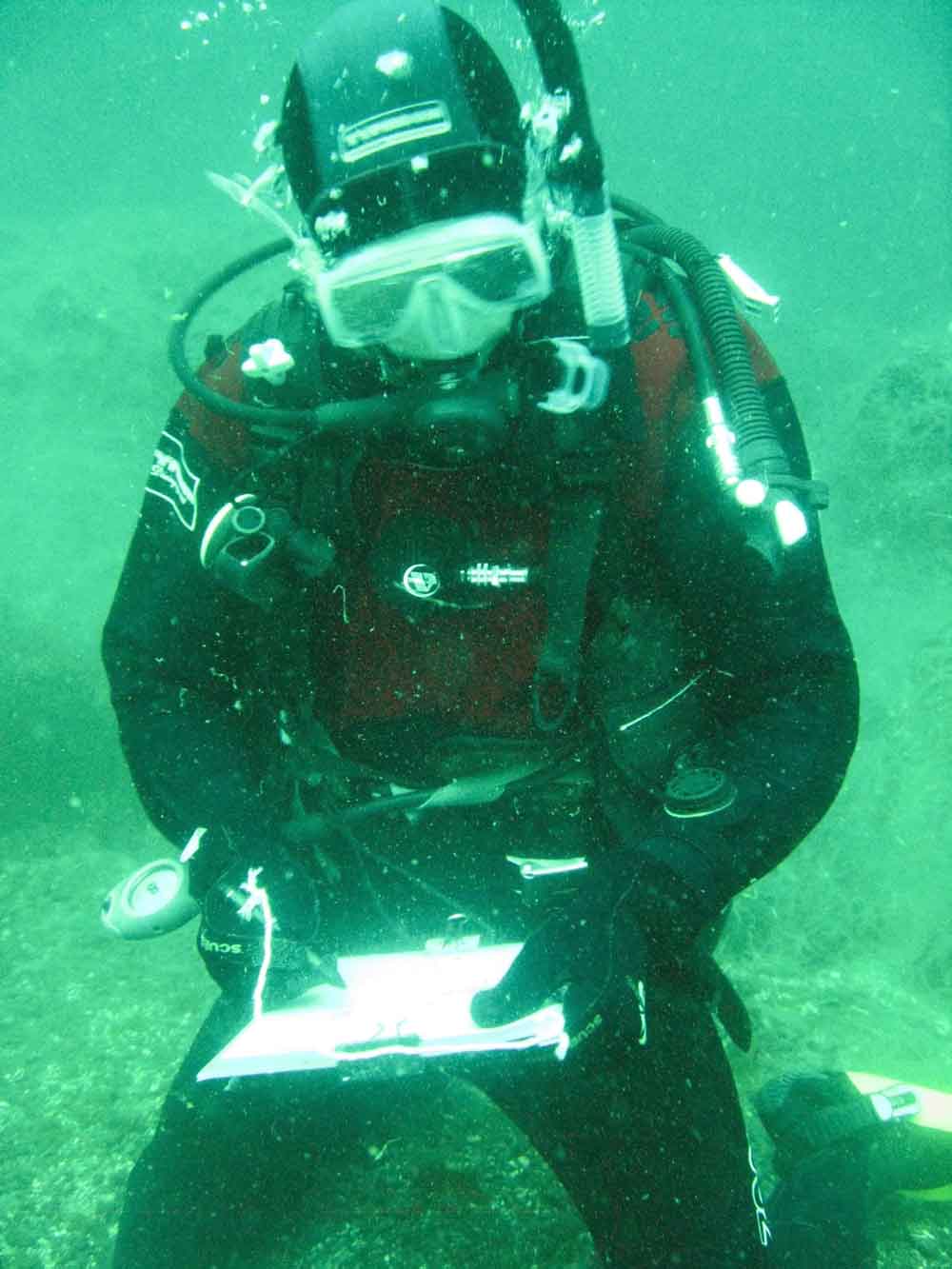
At the end of the dive as we made our safety stop during our ascent I spotted a guillemot swimming above us. We later learnt that the other divers in the party had about sixty birds swimming all around them – maybe next time I’ll be luckier!
Yesterday I took another practice dive at Loch Long on the west coast of Scotland – this time with an underwater camera. I have realised that the restrictions of time, due to a limited air supply, and the practical problems of painting underwater mean that I will have to use some photography as an aide memoire for the dives I will do in the Northumberland rMCZ.
Taking photos underwater is a 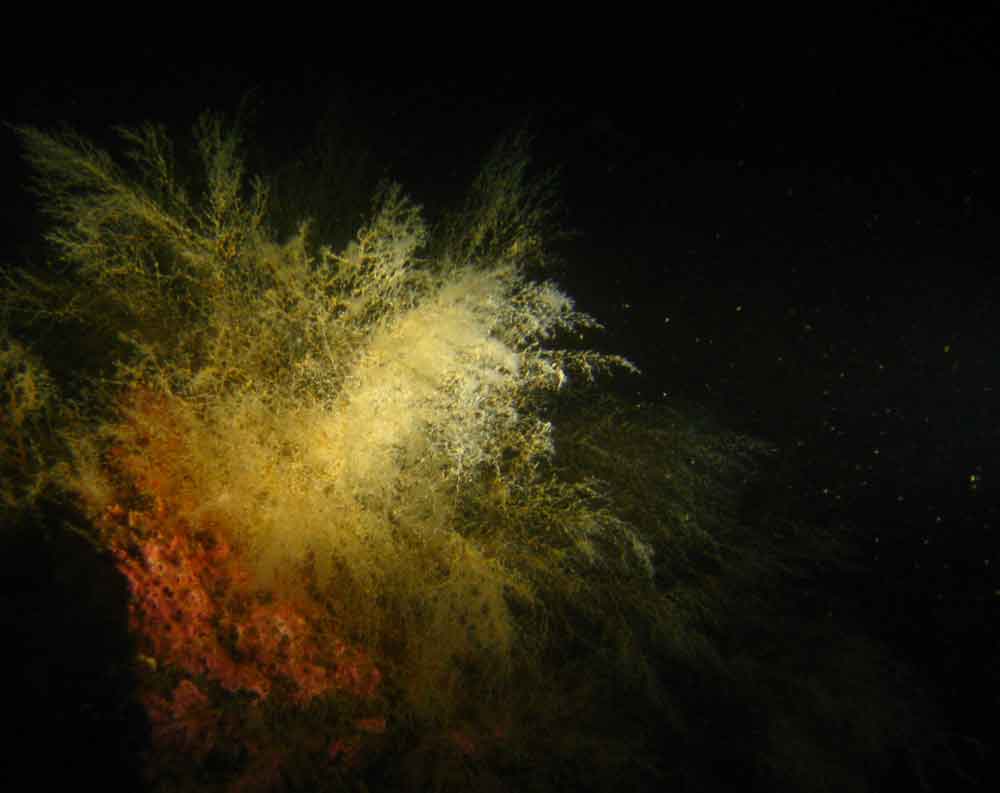 lot harder than you would think, especially when the visibility is under 3 metres. Trying to use the fiddly buttons on the camera when you’re wearing thick, neoprene gloves is like trying to learn the accordian using bunches of bananas instead of hands! Add to that trying to hold your vertical position in the water using your bouyancy control, combatting a horizontal current and trying not to touch anything on the sea bed and you can see that it is a lot harder than taking snaps on land!
lot harder than you would think, especially when the visibility is under 3 metres. Trying to use the fiddly buttons on the camera when you’re wearing thick, neoprene gloves is like trying to learn the accordian using bunches of bananas instead of hands! Add to that trying to hold your vertical position in the water using your bouyancy control, combatting a horizontal current and trying not to touch anything on the sea bed and you can see that it is a lot harder than taking snaps on land!
The built-in camera flash was just bouncing right back off the suspended 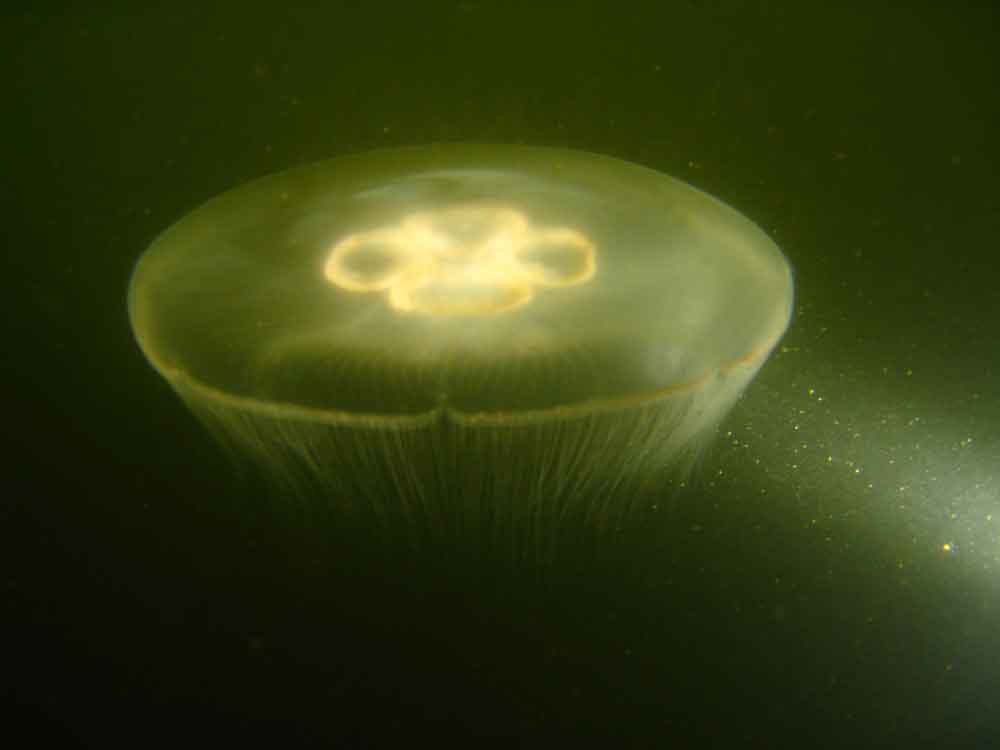 particles in the water (made worse by me kicking up a lot of silt from the sea bed!) so that all my photos looked like out-of-focus pictures of the Milky Way. Fortunately my dive instructor had a torch so these two photos (the best of an otherwise very fuzzy collection of largely unrecognisable images) are not too bad and show a lovely feathery seaweed and a jellyfish, looking for all the world like a UFO from outer space.
particles in the water (made worse by me kicking up a lot of silt from the sea bed!) so that all my photos looked like out-of-focus pictures of the Milky Way. Fortunately my dive instructor had a torch so these two photos (the best of an otherwise very fuzzy collection of largely unrecognisable images) are not too bad and show a lovely feathery seaweed and a jellyfish, looking for all the world like a UFO from outer space.
I was absolutely thrilled to be awarded The Wildlife Trusts‘ Undersea Art Award 2015 recently. This award affords me the opportunity to learn to scuba dive and to then produce a series of drawings and paintings inspired by my adventures beneath the waves. This work will then be displayed at the Society of Wildlife Artists (SWLA) annual exhibition, The Natural eye, at the Mall Galleries, London, later this year.
I can’t wait to get started! Last weekend I finished my dive training and got the thumbs-up to descend into the briny depths of the North Sea which will be the source of my inspiration over the coming summer.
The award is part of The Wildlife Trusts’ Living Seas’ initiative – a plan to try to reverse the severe degradation that the UK’s marine environment has suffered through neglect and over-exploitation in recent decades. Art and conservation have worked together very successfully in the past and with this award The Wildlife Trusts hope to raise awareness, through the medium of art, of the fantastic wealth of species that can be seen under the waves and the need for conservation action.
The area I have chosen to dive and paint is a ‘recommended’ Marine Conservation Zone (rMCZ) along the Northumberland coast, broadly between St Mary’s Island just north of Newcastle and Coquet Island near Amble to the north. It is one of 23 places which the government is currently considering for designation in order to make up a network of protected areas at sea – they’ll be announcing their decision later in the year.
The amazing reef systems within the rMCZ provide habitat for a great diversity of marine life from anemones, polyps and soft corals to large numbers of molluscs, starfish, crabs, lobsters and fish, and some strikingly pretty sea slugs that I would love to see!
St Mary’s Island is already a voluntary marine reserve, and Coquet Island is European Special Protection Area, an RSPB managed reserve and a haul-out and breeding area for grey seals, which are protected under the EC Habitats Directive. Protecting the seabed around these islands would help to sustain important foraging areas for birds and seals.
However, the area is subject to a lot of human pressure. Recreational and commercial fishing, for example, has left a large amount of discarded fishing line and net that kills marine life by entanglement, and litter is a problem with anything from plastic bags to a gas cooker being found on the sea bed.
By diving this area and painting some of what I see I hope to encourage an appreciation of our local marine environment and to foster a genuine concern about its continued degradation. We cannot continue to treat our sea as an unlimited food basket, a playground and a rubbish dump – it is a fragile, delicately balanced ecosystem that we all rely on. With the appropriate level of protection our coastal seas can recover but only if we act now. It will be of benefit to us all.
Over the course of this summer and autumn my blog will be devoted to charting my progress through this bursary project, from taking the very first tentative breaths underwater to the final sketches and studio paintings. I hope you will enjoy the journey with me!
You can find out more about Marine Conservation Zones here
http://www.wildlifetrusts.org/mcz and further information about Coquet to St Marys rMCZ http://www.wildlifetrusts.org/MCZ/coquet-to-st-marys
Chris Packham is soon to post a nightly ‘as live’ You Tube diary covering the appalling, Spring slaughter of migrant birds that happens for so-called ‘sport’ on Malta every year. The aim is to raise awareness of this mindless massacre of migrant birds as they pass through Malta from Africa to reach their breeding grounds in Europe each Spring. Anything that moves is shot; from tiny warblers and swallows to herons, storks, doves and birds of prey – everything is fair game. They are killing ‘our’ birds for no better reason than target practice; they don’t even eat them. Thousands of birds die every year but, horrifyingly, it is still legallised on Malta despite an EU Birds Directive that it is illegal! Small birds are often lured to bushes using previously trapped, live birds that are literally glued to a branch using sticky lime; their calls attract the migrants which are then similarly caught on limed branches or just shot out of the air. I urge, I implore you to look at Chris Packham’s video diaries later this month and to follow the story through this link; http://tinyurl.com/q5f2rtk With enough support we might be able to shame the Maltese government into putting a stop to this dreadful, annual massacre.
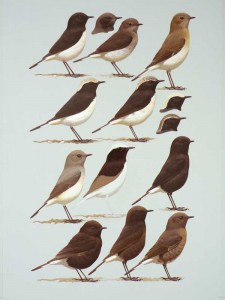
Plate 45
I’m busy working on corrections and alterations to a new book Robins and Chats of the World. This is plate 45 featuring Variable wheatear (Oenanthe picata) and I’ve just blocked in the last figure – a first year male of the race or form capistrata, for those who are interested in such things! There will be 64 plates like this illustrating nearly 150 species from around the world. I’ll post the finished figure shortly, when I’ve had a cup of tea!
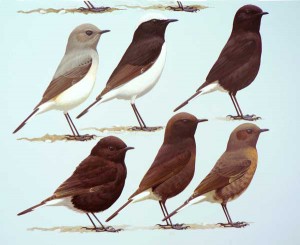
Plate 45 Detail
The top centre figure is the one I’ve just finished. To the left of it is the female and the remaining figures are of the race opistholeuca.
Prints are available for sale from £45
each. Payments are via PayPal.
Hawfinches &
Winter Thrushes
£50 (inc UK delivery)
Share